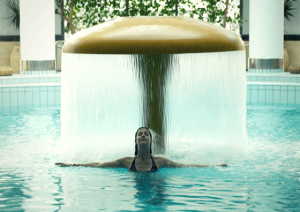
Since antique times water has served as an essential part of religious purifications, healing rituals and beauty treatments. But could water’s importance be just a tradition that we have inherited from our ancestors or does it have real healing effects? And what is water therapy exactly?
To answer these questions one has to go back in time a long way. Once upon a time, some million years ago to be precise, the ancient, primal sea covered the planet. Minerals, salt, mud, clay and algae we use for treatments today can be traced back to that time. Water is indispensable to Life and all our life depends on it. The adult human body, to give one example, is composed of 60-70 % of water. As our cells contain intracellular fluid and are surrounded by extracellular fluid it is highly important to be correctly hydrated, otherwise the stability and function of cells and organs would capsize. And yes, already our forefathers knew of the beneficial responses of water therapies.
Hydrotherapy, formerly called Hydropathy, is a generic term for water therapy treatments, which use the physical properties of water like its temperature and pressure. Hydrotherapy is also a collection of dozens of water-based treatments: hot and cold compresses, baths, steams, jets, hoses, underwater massages, cold plunges, Kneipp treatments and even drinking water, which are applied for easing pain, treating certain diseases, relaxing and enhancing general well-being.
Balneotherapy is considered a hydrotherapy method, which uses water –preferably mineral water – for bathing and immersing. Several physiological changes go through the human body during immersion in water. It involves the renal, respiratory, endocrine, immune, lymphatic, muscular, the digestive, the metabolic and the nervous systems and has cardiac effects to the heart and circulatory system as well. These therapies work based on the buoyancy of the water, which helps to reduce the body weight by 90 %.
Hydrotherapy was used in India already 5,000 years ago! We inherited water, essential oil, herbal and flower remedies from Egypt, which is going back to 3,000 BC. Steam and mud bath was favored in the ancient Persia already in 600 BC. Despite of the fact that these ancestral cultures used several water-based therapies, we still believe that our hydrotherapy and balneotherapy treatments really originate from the Greeks.
The traditional Roman bathing was explored and developed mainly by the European countries where the Roman Empire existed, like in today’s Germany, Hungary, Italy, Switzerland, the Czech Republic, France and England.
The therapeutic effects of exercising in water are countless. Here are a few:
- Helps to stretch and develop muscles
- Improves flexibility
- Improves balance and coordination
- Boosts blood circulation
- Corrects the skeleton system
- Promotes the lymphatic system
- Stimulates the elasticity of the skin
- Improves the digestive system
- Enhances aerobic capacity
- Eases painful joints
- Increases oxygen consumption
- Improves breathing and sleeping patterns
- Reduces stress
- Promotes relaxation
Let’s see some examples for water therapy treatments:
Hydrotherapy treatments
- Vichy showers (affusion shower, rain shower): Person lies on a table, water raining down on the entire length of the body from multiple jets.
- Scotch Hose (jet, blitz): High-pressured spray is directed to certain areas of the standing body – from toe to head.
- Swiss Shower: The showerhead is pointed over client’s head and multiple jets surrounding at various heights, using different pressure and speed.
Aquatic Exercises
- Watsu: (Water + Shiatsu)
- Jahara: a.) The client is floating safely in water, providing body support and aquatic bodywork. b.) It consists of micro-adjustments of the structural alignment of the body. c.) It is focusing on breath control under and above the water.
- Ai Chi: Deep breathing and slow movements are combined, using a combination of tai chi, shiatsu, watsu and aquatic exercise.
- Water Dance: Patient is taken under the water and moved, cradled, stretched, combined with gentle massage movements.
- Aqua Wellness: Combination of gentle stretching movements and deep tissuemassage.
- Aquatic fitness: Treadmills or bikes are placed in the water and the exercises are performed with the same routine as on the ground.
- Aquatic therapy: Physical therapy is executed in pool with a trained professional who is involved to supervise the physical rehabilitation. Injured, disabled people can comfortably exercise in water.
Meditative water therapies
- Liquid sound: Under and above water light and music are used to relax and calm the exercising and floating body.
- Flotation: Applied in flotation tanks or dedicated pools, baths, which are filled with salty, thermo-neutral temperature water. Lack of sounds, light and gravity takes the body and mind to a meditative state.
Thalassotherapy also belongs to water therapies. For more information please read one of our previous article “What is Thalassotherapy”.
Contraindications
As always, we should keep in mind, though, some precautions before taking a water therapy. Open wounds, severe kidney disease, uncontrolled epilepsy, skin disease, eczema and other infections are contraindications to water therapies.

I’m impressed! You’ve managed the almost imoisspble.